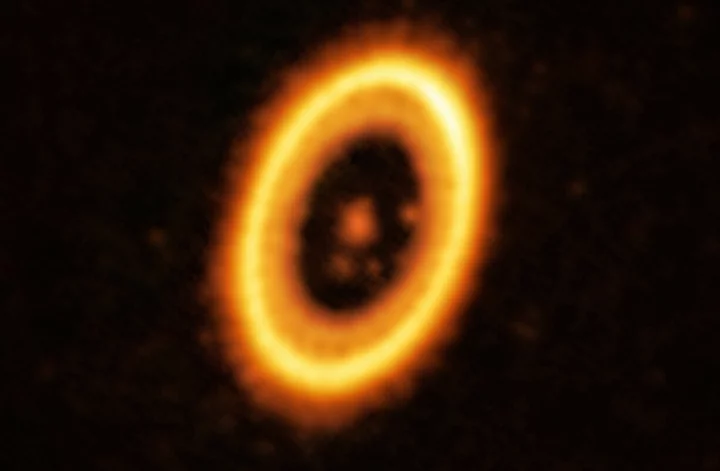Astronomers think they've found the first pair of planets sharing the same orbit around a star, something never before seen in space.
A confirmed planet circling PDS 70, a star about 370 light-years from Earth in the constellation Centaurus, appears to have a mysterious companion. Along the known world's orbit, the team detected a debris cloud, which they say could hold the makings of a new planet or the leftovers of one already formed.
In our solar system, co-orbiting objects, referred to as Trojans, are fairly common. The prime example is the Trojan asteroids, some 12,000 space rocks traveling in two swarms along Jupiter's orbit around the sun, one leading the planet and the other trailing behind.
Experts have predicted Trojan planets should also exist in the universe. But finding the proof has been tough.
"Exotrojans have so far been like unicorns," said Jorge Lillo-Box, one of the astrophysicists on the team, in a statement. "They are allowed to exist by theory, but no one has ever detected them."
SEE ALSO: The curious planets scientists have ogled in 2023, so farThe already confirmed planet, PDS 70 b, is a gas giant, perhaps four to 17 times heavier than Jupiter, about 2 billion miles away from its star. That's roughly the distance of Uranus from our sun. Based on the team's findings, the debris cloud, located some 1.3 billion miles away from PDS 70 b in the loop around their star, holds about double the mass of Earth's moon.
The team used the ALMA telescope, run in partnership with the European Southern Observatory, to make this detection. The research was part of the Troy Project, a deliberate effort to find the first so-called "exotrojans" — Trojan planets outside our own solar system — and study their impact. The new findings, led by Olga Balsalobre-Ruza, a doctoral student at the Centre for Astrobiology in Madrid, are published in Astronomy & Astrophysics.
"They are [thought to be] like fossils of planetary formation, since they form at the same time as the planet," she told Mashable. "They can harbor a lot of information about the chemicals and conditions in the system when forming, but also about the evolution of the system."
PDS 70 is a star about 370 light-years from Earth in the constellation Centaurus. Credit: ESO / Digitized Sky Survey 2 / Davide De MartinWhat scientists know of Trojans already is that they reside in so-called Lagrange zones. These particular regions are special because the gravitational pulls of the planet and host star are at equilibrium and can trap objects there like an invisible cat's cradle.
In Jupiter's orbit, for instance, the Trojan asteroids can't seem to escape, a major reason why astronomers think they so far haven't seen any meteorites on Earth made of Trojan rock material. NASA's uncrewed Lucy spacecraft will explore these mysterious rocks, thought to be remnants of the early solar system, during the probe's 12-year asteroid tour.
Want more science and tech news delivered straight to your inbox? Sign up for Mashable's Light Speed newsletter today.
The Trojan asteroids are some 12,000 space rocks traveling in two swarms along Jupiter's orbit around the sun, one leading the planet and the other trailing behind. Credit: NASAThe idea of co-orbiting planets has been around for a couple of decades. In a 2002 paper, scientists presented the notion with a few possible explanations for how Trojan exoplanets might come to be. One possible scenario describes a major collision between two primitive planet cores in a young solar system, similar to how theorists believe a giant impact formed Earth's moon. The difference would be that the secondary planetary body would not be trapped within the main planet's gravitational force.
The PDS 70 system became a target of these Trojan exoplanet hunters because it is the only confirmed planet nursery, with baby worlds in the midst of forming. The host star is 6 million years old, which may seem ancient but is actually quite young compared to the sun, a middle-aged star at 4.5 billion years old.
PDS 70 b, along with another primitive gas giant planet, PDS 70 c, are still feeding off material from their star. These planets are surrounded by a planet-forming disk of gas and dust, with a wide gap carved out by the planets.
"Exotrojans have so far been like unicorns. They are allowed to exist by theory, but no one has ever detected them."It would be difficult at this point to make any assumptions about the potential Trojan exoplanet. It would share the same relative distance from its host star as PDS 70 b, but its climate could differ depending on what the co-orbiting planet is made of, if it has a tilt, and if it rotates on its axis. While siblings could be made out of similar material, the Trojan isn't necessarily another gas planet, but perhaps more rocky like Earth, Balsalobre-Ruza said.
"It could be, and maybe it's more likely," she said.
PDS 70 b, along with another primitive gas giant planet, PDS 70 c, are still feeding off material from their star. Credit: J. Olmsted (STScI) illustrationThe team pored through archival ALMA telescope data on the Lagrange zones in PDS 70 b's orbit, detecting a faint signal from one of them. The next step will be to confirm the detection in February 2026, when scientists plan to use the same observatory in Chile to see if both PDS 70 b and the cloud of debris move along the orbit together. There is still a chance that what they found isn't a Trojan exoplanet but another primitive planet forming on a separate orbit.
Balsalobre-Ruza expects to be a part of the team that will attempt to confirm the detection. If what they suspect is true, it could provide concrete support for the idea that Trojan planets are a natural occurrence in the planet-forming process.
"That would be amazing and a breakthrough for the field that I wouldn't think would happen, at least so early in my career," she said.









